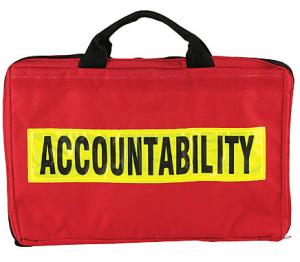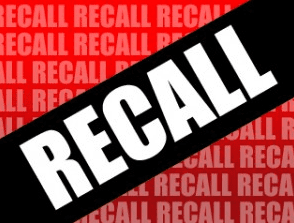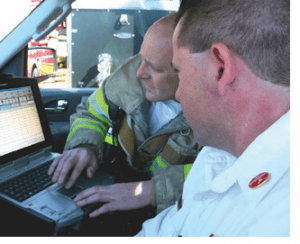 Accountability: A critically important component of emergency scene safety when personnel operates in a hazardous environment. From the perspective of situational awareness, accountability plays several roles. The obvious role is personnel accountability facilitates the rapid deployment of rescue teams if something goes awry. Command knows the crew sizes and where they are operating and can send help expeditiously.
Accountability: A critically important component of emergency scene safety when personnel operates in a hazardous environment. From the perspective of situational awareness, accountability plays several roles. The obvious role is personnel accountability facilitates the rapid deployment of rescue teams if something goes awry. Command knows the crew sizes and where they are operating and can send help expeditiously.
Additionally, accountability plays a second role that is critically important to the development and maintenance of situational awareness – projecting the future. The highest level of situational awareness is prediction – having the ability to accurately determine what is going to happen as the emergency plays out. Essential to this skill is knowing crew sizes, crew locations, and crew task assignments. The crews, performing the tasks at the emergency scene, are the proverbial actors in a movie the commander is playing in their head – a movie that’s looking at the FUTURE of the event. The goal when looking into the future is simple: See the bad things coming in time to prevent a bad outcome.
But how should a commander (or an accountability officer) track the movement of personnel to ensure the accuracy of the information? That is the topic I will be addressing here.
Name Calling
How should a crew be addressed over the radio? There are, essentially, four options I can come up with:
Personal identifier: (e.g., Battalion 6, Captain 1, Firefighter 209, etc.)
Vehicle assignment: (e.g., Engine 1, Squad 14, Ladder 9, etc.)
Geographic location: (e.g., Division 1, Roof, Interior Team 1, etc.)
Primary task assignment (e.g., Attack, Vent, Search, etc.)
The goal is to ensure that if something goes wrong, the crew size, their location and the task they were performing can be easily identified. There are, without a doubt, both advantages and disadvantages to any identification nomenclature.
Ease of Recall Under Stress
 When I look at matters like this, admittedly, my view is from one of cognitive neuroscience and sometimes this can run counter to national standards, like NIMS. Until brain scientists and bureaucrats collaborate on the design of national policies and standards, we’ll just have to be content with understanding that what may be determined to be best by one will not be embraced by the other. Such is the messiness we face in life.
When I look at matters like this, admittedly, my view is from one of cognitive neuroscience and sometimes this can run counter to national standards, like NIMS. Until brain scientists and bureaucrats collaborate on the design of national policies and standards, we’ll just have to be content with understanding that what may be determined to be best by one will not be embraced by the other. Such is the messiness we face in life.
Operating at emergency scenes is stressful. This stress impacts the ability to capture, store and recall information. This fact becomes critically important as you consider the cognitive effort required to maintain accountability. The goal is for the information about crew size, location and task to be readily accessible, both for rescue purposes and for being able to predict future outcomes based on what those crews are doing.
Ease of information storage and recall is the objective. If things go bad, there won’t be time to do a lot of information sorting and reconstruction. The accountability records, be they written or simply from memory, should be crisp, clear and easy to comprehend.
You Hear With the Visual Processor in Your Brain
 When information is shared audibly, the receiver of the information forms visual images in their mind to aid in the comprehension of the information. For example, if a crew operating on the interior of a structure fire said they were belly-down, on the floor, in zero visibility conditions, every trained responder on the scene who hears that message will form a vivid visual image in their mind of the conditions that crew is facing.
When information is shared audibly, the receiver of the information forms visual images in their mind to aid in the comprehension of the information. For example, if a crew operating on the interior of a structure fire said they were belly-down, on the floor, in zero visibility conditions, every trained responder on the scene who hears that message will form a vivid visual image in their mind of the conditions that crew is facing.
Call it As You See It
In the spirit of brain science that explains how we comprehend what we hear, I offer this recommendation: Identify crews in a way that when they call on the radio, the commander, the safety officer and everyone else operating on the emergency scene will know who is calling, what they are doing, and where they are. Let’s put it to the test.
I’m going to provide several examples of radio traffic and you decide for yourself which helps you form the best visual image of what is happening:
A: “Captain 1 to command, our crew is making progress on the second floor.”
B: “Engine 1 to command, our crew is making progress on the second floor.”
C: “Division 2 to command, our crew is making progress” (don’t have to say what floor as Division 2 is the geographic identifier).
D: “Attack Team 1 to command, our crew is making progress on the second floor.”
Absent any other information, which statement is the best at helping you understand what’s happening?
If the commander only has a few companies working at an incident, what each crew calls themselves may be inconsequential because they’ll be easy to track. However, as incidents grow in complexity, the ability to remember what each Captain’s assignment is, for example, coupled with where they are operating at could become quite challenging.
Command Has it Easy
When it comes to managing information, a commander who is properly located (i.e., away from the action and able to maintain a visual fix on the incident) is in the best position to keep track of things. Using a worksheet to write things down can be a tremendous asset for keeping track of personnel.
Crew size, location, task assignments can readily be tracked. But what about all the other crews who are operating hands-on? They are in a far more hostile environment and their ability to keep track of who’s where, doing what, is far more challenging, yet none the less important.
When operating at an emergency scene there are multiple situational awarenesses, including:
Personal situational awareness: A crew member’s awareness of his or her own surroundings.
Team situational awareness: A shared awareness of team members about what is happening in their collective surroundings.
Incident situational awareness: A holistic awareness of the big picture and how the actions of teams are complimenting or impacting the performance of each other to the completion of the overall strategic objectives.
Using a structure fire as an example, a firefighter would have personal situational awareness as clues and cues about his or her environment are captured and processed, including incident conditions and information about personal safety and perhaps information about fellow crew member’s abilities.
The company would also develop team situational awareness that ensures they are on the same page tactically, they have made similar assessments about the conditions, they have collaborated on goals and they are supporting each other (i.e., behaving as a team, versus a group of individuals).
The incident situational awareness is developed from understanding how individual and team performance impacts the overall incident’s strategy and objectives with a keen awareness of the impact and consequence of failure and success.
I share all of this because each individual and team needs to be as aware of what others are doing as much as they are aware of their own role. With that in mind, put yourself in the role of a company officer, working with your crew in the basement of a residential dwelling fire and, with all the stress and other barriers to situational awareness present, you must try to keep track of who’s who and what they are doing. Would that be easier if you were hearing crews being identified using:
A: Personnel identifiers (e.g., Captain 1, Lieutenant 41, Firefighter 192)?
B: Apparatus assignments (e.g., Engine 7, Ladder 22, Squad 18)?
C: Geographic locations (e.g., Roof, Division 2, Interior Team 1)?
D: Primary task (e.g., Vent, Attack, Search)?
If you were belly-down in the basement and there was a considerable amount of radio traffic, which of the above would be easiest for you to identify with that would help you understand whose calling on the radio, what they are doing, and how their goals are supporting your goals?
The Gold Standard
 Is there a way to bring resolution to this issue that may address the concerns and needs of everyone? Perhaps there is. What if, for each crew assigned, they actually used multiple identifiers for each radio transmission. Granted, for this system to work there needs to be an element of radio discipline that, quite frankly, is missing in many organizations. This is unfortunate on many levels because flawed communications is ALWAYS a significant finding in every casualty report I have read, no exceptions. What would the communications sound like if multiple identifiers were used? Here are some examples:
Is there a way to bring resolution to this issue that may address the concerns and needs of everyone? Perhaps there is. What if, for each crew assigned, they actually used multiple identifiers for each radio transmission. Granted, for this system to work there needs to be an element of radio discipline that, quite frankly, is missing in many organizations. This is unfortunate on many levels because flawed communications is ALWAYS a significant finding in every casualty report I have read, no exceptions. What would the communications sound like if multiple identifiers were used? Here are some examples:
Team identifier + crew size + location + update report
Engine 1, crew of 3, on Division 2 Attack. We have a knockdown on the fire.
Personal identifier + crew size + location + update report
Captain 1, with 3, on Attack in the basement. Conditions are not improving.
TMI, TMI!
One of the criticisms I sometimes receive when I make this recommendation is this solution creates too much radio traffic (i.e., Too Much Information – TMI!). I was recently told this while having a conversation with a chief following my review of a radio tape of an incident where things did not go well. The radio traffic at this incident could serve as the poster child for incident communications gone bad. It was horribly confusing and horrendously difficult to track (and I was listening to it with headphones on in a conference room).
When a crew got into trouble, the command didn’t have any idea of the crew’s size, location or task. Command was overwhelmed. Other crews then started chiming in, asking for information about the crew size and location of the crew in trouble. The incident quickly spiraled out of control because of a Hail Mary effort to develop collective situational awareness about where everyone was and what they were doing. Needless to say, it didn’t work well for them and it rarely works well for others. Even if the outcome is good (i.e., no one gets hurt) the potential for catastrophe is tremendous.
Dr. Gasaway’s Advice
You only need to go as far as to review the recording of your past 3-5 significant emergency calls to know if your system of tracking, crew identification, and accountability are working well. If they aren’t, the time to fix it is now.

Action Items
- Obtain a copy of the radio tape of some recent significant incidents you’ve had. Evaluate the challenges experienced with tracking personnel, crew sizes, locations and task performance.
- Discuss best practices for training personnel on how to properly talk on the radio. Identify ways to build radio communications into every training session.
- Discuss how individual, team and incident situational awareness is developed and maintained at your emergency scenes. Seek to identify opportunities for improvement.
About the Author
Richard B. Gasaway, PhD, CSP is widely considered a trusted authority on human factors, situational awareness and the high-risk decision making processes used in high-stress, high consequence work environments. He served 33 years on the front lines as a firefighter, EMT-Paramedic, company officer, training officer, fire chief and emergency incident commander. His doctoral research included the study of cognitive neuroscience to understand how human factors flaw situational awareness and impact high-risk decision making.
_____________________________________________________

If you are interested in taking your understanding of situational awareness and high-risk decision making to a higher level, check out the Situational Awareness Matters Online Academy.
CLICK HERE for details, enrollment options and pricing.
__________________________________
Share your comments on this article in the “Leave a Reply” box below. If you want to send me incident pictures, videos or have an idea you’d like me to research and write about, contact me. I really enjoy getting feedback and supportive messages from fellow first responders. It gives me the energy to work harder for you.
Let’s Get connected
Facebook: SAMatters
LinkedIn: Rich Gasaway
LinkedIn: Situational Awareness Matters
Twitter: Rich Gasaway
Youtube: SAMattersTV
itunes: SAMatters Radio
Stitcher Radio: SAMatters Radio
Google Play: SAMatters Radio
iHeart Radio: SAMatters Radio

